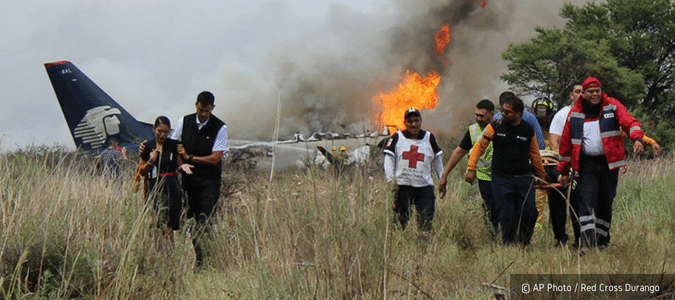103 People Survive Fiery Crash of Aero Mexico Flight 2431: Why Did the Plane Crash?

Why Did Aero Mexico Flight 2431 Crash?
Based upon passenger reports and video taken by passengers on the Aero Mexico Flight 2431 which crashed near Durango, Mexico on July 31, 2018, the aircraft took off in adverse convective weather conditions commonly referred to as a thunderstorm. Passengers reported the aircraft started its takeoff roll in rain and encountered turbulence, heavy rain and hail shortly after takeoff.
The environment in and around an active convective cell can be very dangerous for an aircraft, especially those attempting to take off and land. Aircraft landings and take offs are very vulnerable to the adverse effects of a thunderstorm in the vicinity of an airport, even if the center of the storm is 20-30 miles away. In the Aero Mexico crash, witness reports suggest that a “hot” cell was very close to the airport and on the departure path of the aircraft.
How Dangerous Are Thunderstorms During Flights?
Thunderstorms can generate wind shears, strong downdrafts or microbursts, as well as heavy rain and hail. Wind shears are rapid changes in wind direction and speed relative to adjacent air. Pilots attempting to take off into a head wind can suddenly encounter a wind shear that produces a tail wind and the aircraft loses its lift. A strong downdraft or microburst can produce columns of air moving downward that exceed the aircraft’s ability to climb. The mix of downdrafts and wind shears can also alter the angle of attack over the wing and produce an aerodynamic stall and loss of lift. Hail and heavy rain entering the inlet of a turbine engine can cause a partial or complete loss of engine power.
Previous Accidents Involving Convective Activity
In the U.S., Delta Flight 191 at DFW Airport (1985) and American Airlines Flight 1420 at the Little Rock National Airport (1999) both involved fatal airline crashes where the aircraft encountered convective activity in the vicinity of the airport while attempting to land.
In the case of Delta 191, the pilots flew through a convective cell with a strong downward column of air called a microburst. The effect of the microburst and wind shears associated with it dramatically altered the angle of attack of the wing, causing a stall with the vertical column of air slamming the stalling aircraft into the ground.
With American 1420, the pilots elected to attempt a landing at the Little Rock airport with a thunderstorm converging on the airport. Landing to the north, the pilots did not arm the spoilers, a braking device, and as the aircraft touched down, weather data showed that the wind had shifted to impose a tail wind on the landing airliner. The aircraft ran off the end of the runway, crashed through structures and ended up in a marshy area next to the Arkansas River. Both Delta 191 and American 1420 experienced post-crash fires.
Contact Slack Davis Sanger
Slack Davis Sanger has experience with these types of crashes, having represented 25 surviving passengers and the family of two deceased passengers from American Flight 1420, and the families of six deceased passengers from Delta Flight 191. Our attorneys are pilots and include a former NASA engineer, so they understand the technical nature of plane crashes. If you or someone you love has suffered an injury in a plane crash, let us help. Our experienced and dedicated attorneys have a proven track record in personal injury law, including major litigation related to aviation accidents. We work tirelessly for our clients to get the results they deserve. Contact us for a free consultation.
